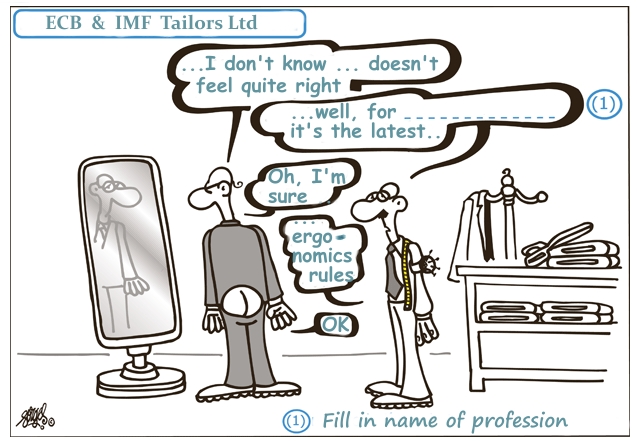Narrative & dialogue, image & phrase
Saturday 29 October 2011
In the Op/Ed section of El Pais, they publish two first class cartoonists every day – Forges and El Roto. These two guys maintain an astonishingly high level, given that they produce witty, thought-provoking up-to-the-minute graphic comment daily, and have been doing so year in year out, for decades in the case of Forges.
The interesting thing to me is that the two are highly complementary in their styles and approaches to the art of the satirical cartoon. One uses a base of narrative and dialogue, the other uses a base of image and phrase. Let me expand these ideas, using a recent example of each's work – I've had to translate the text from the original Spanish (I hope they don't mind!) ...
Here's Forges :

Typical Forges characters – two slightly seedy and balding Average Blokes very seriously discussing a surreal idea. We immediately fill in the Narrative – rather boring administrator, seeking to buy a suit to improve his image and career, consults world-weary tailor who nonetheless has the latest sales pitch ready. Their characters are developed by the Dialogue. And outside the central action, the context and meaning are supplied by the 'shop-sign' and the 'footnote' - “we are all being buggered by the European Central Bank and the International Monetary Fund in the name of 'efficiency'”. Elegantly economical technique, acidic comment.
And here's El Roto :

What hits you first is the Image -a big black intimidating shape with slightly crazed beady eyes. Then you read the Phrase, and realise that the Thing has stern simple ideas. Does It realise that there is a paradox in teachers being taught …? Note that El Roto rarely uses more than a dozen words, only occasionally has a dialogue exchange, and sometimes has no words at all. The Phrase is often a deliberately-chosen cliché – it's the Image that reveals the real point.
There are two elements of spanish Context which make this graphic more resonant. The Image is dark and primitive, suggesting the term 'la caverna', used by some to label political neanderthals lurking in their ideological caves and stamping out to beat about the head with crude stone clubs anything remotely progressive. When published, the Phrase immediately called to mind the ongoing brutal cuts in public education – and particularly the remark of right-wing Madrid politician Esperanza Aguirre that 'most people in Madrid would love to work only 20 hours a week like teachers'. After a stunned pause, the entire educational profession leapt on Aguirre, pointing out that the figure of 20 hours referred simply to hours in the classroom, and that teachers actually did rather a lot of work outside the classroom as well. Remarkably, Esperanza Aguirre is a former Minister of Education.
But the precise Context is not essential – it is the image of the Thing and its crude message that really does the work.
I would argue that the work of these two cartoonists is genuinely international, and (after basic translation) would be understood, seen as relevant, and would raise a grin in most cultures anywhere in the world.
That's class.

